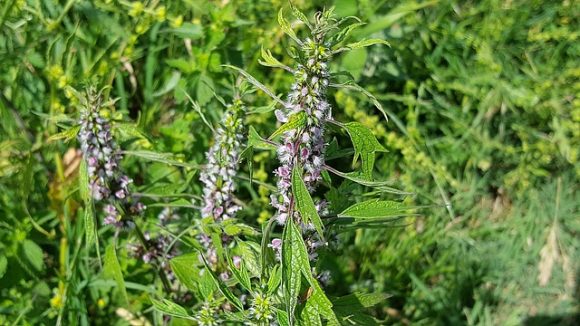- The Miraculous Shiny Bush Plant - January 18, 2021
- Colorful, Edible and Medicinal Celosia - January 10, 2021
- Radish, a Nutritional Power House - December 19, 2020
Motherwort, also known as lion’s tail, throw-wort or lion’s ear and botanically known as leonurus cardiaca, is an upright shrub with dark green leaves belonging to the mint family. It is native to Europe and Asia but is now common in other regions including the US where it is considered an invasive weed in some states.
[Disclaimer: Motherwort contains essential oil with a lemon scent that is known to cause photosensitivity when ingested. The leaves can also cause contact dermatitis in people with sensitive skin. The Right Flowers is not a medical site. Knowledge of and information about the therapeutic benefits and applications of flowers, while known through the ages, does not constitute medical advice. If you are having health issues, you should consult with a physician.]
The plant earned the name “motherwort” due to its ability to manage and soothe aches, pain, and tension associated with childbirth, menstruation, pregnancy, and menopause. Motherwort is known to relax and strengthen uterine muscles which help in easing gynecological problems.
Motherwort’s genus name ‘leonurus’ meaning lion’s tail is based on the appearance of the plant which people thought looked like a lion’s tail. The specific species name, ‘cardiaca’, means for the heart. It refers to the early association of the plant with cardiovascular health.
Motherwort is known to be highly beneficial to menopausal women. Basically, menopause comes with many complications including palpitations, irritability, and panic attacks. The plant contains leonurine, a compound with antiarrhythmic, antidepressive, antioxidant, anti-inflammatory and neuroprotective effects. These properties help in regulating heart palpitations, moodiness and panic attacks in menopausal women.
Normally, the leaves and flowers of motherwort are the parts used to prepare herbal remedies, however, the whole herb is useful for medicinal purposes. Motherwort is often harvested in August when it is in full bloom mode and dried for later use.
Unlike its close relatives in the mint family, motherwort is bitter and has a pungent odor. The plant produces hairy pink or purple flowers from July to September. Curiously, motherwort rarely survives in cultivation but thrives in the wild. It commonly occurs along riverbanks, in meadows, neglected gardens, and yards.
Motherwort was widely prescribed by Greek physicians to calm nerves during childbirth as they believed that it had tonic effects on the nervous system.
The plant contains diterpenes, phenylpropanoids, monoterpenes, flavonoids, and phenolic acids as well as phytosterols. It also contains sterols, lectins, volatile oils, and tannins.
Good for blood circulation
The plant has been shown to have a lot of potential in enhancing blood circulation and regulating blood viscosity. In a study involving 105 patients, 94.5 percent of the patients using the herb experienced a significant improvement in blood viscosity.
Regulates hyperthyroidism
Hyperthyroidism occurs when the thyroid is too active and is considered among the most difficult conditions to manage holistically. However, motherwort can calm and regulate the hyperthyroid as well as complications arising from this disorder such as racing heart, irritability, and irregular menses.
Though motherwort is not easy to cultivate in a flower garden, if you manage to get it going, it will require little care but the plant will cheer you with its many health benefits.





